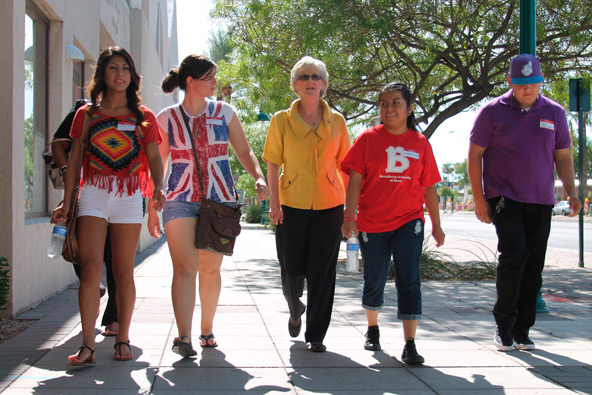
MESA — Benedictine University at Mesa is poised to bloom alongside the city’s revitalization efforts as campus life emerges the week of Aug. 26.
While two other colleges are opening in downtown Mesa, Benedictine University is the only one to open its own space. Administration is located at 51 E. Main Street while other facilities will be located 225 E. Main Street. This marks the third campus for the 125-year-old liberal arts school, but the first outside of Illinois. Building from scratch gave administrators the chance to try something new while retaining the school’s Catholic core.
Benedictine University at Mesa is a non-profit school ranked among the nation’s top most affordable Catholic campuses. Students should expect an education of the mind, body and spirit guided by Benedictine values.
“Physically, you’re going to know you’re at a Catholic campus when the hub revolves around the presence of Christ,” said Tony Siebers, director of student services.
The chapel with a tabernacle will always be open to students and faculty with weekly liturgies following reconciliation. Siebers said top-notch Catholic theologians and guests, including Patrick Madrid, are already scheduled to visit.
Freshmen are required to take two theology classes. Students this year will discern the impact of God’s love and justice. Fr. Dan Vanyo, chaplain, will be available in his office or at nearby Queen of Peace Parish.
“My goal is to help the university realize its Catholic identity and help both teachers and students grow more in love with Christ and His Church,” Fr. Vanyo said.
He will also work with the university’s Catholic advisory committee to identify how the Catholic vision of Benedictine University will be lived out in the diocese. Siebers envisions all students, especially nutrition majors, having much to offer the community.
New initiatives include a student housing option at the nearby Phoenix Marriott Mesa, access to the local YMCA and problem-based learning. Classrooms and even some hallways are primed for small group discussion and collaboration. A multi-panel glass décor outside of the computer lab acts as a whiteboard allowing students and instructors to brainstorm solutions.
“The first time ever, you’re going to be asked to take out your phone in class,” Carrie Lewis, who oversees campus technology, said during a mock “lecture-free” class.
Students will use cell phones to text responses that are automatically converted to a chart beamed across multiple flat screen monitors.
“It’s not so much a way for us to remember every little detail, it is a way for us to take the knowledge they give us and apply it to the community,” freshman Alberto Carrazco said. 






